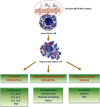Deciphering the structure and function of FcεRI/mast cell axis in the regulation of allergy and anaphylaxis: a functional genomics paradigm
- PMID: 22146792
- PMCID: PMC11114762
- DOI: 10.1007/s00018-011-0886-0
Deciphering the structure and function of FcεRI/mast cell axis in the regulation of allergy and anaphylaxis: a functional genomics paradigm
Abstract
Allergy and anaphylaxis are inflammatory disorders caused by immune reactions mainly induced by immunoglobulin-E that signal through the high-affinity FcεRI receptor to release the inflammatory mediators from innate immune cells. The FcεRI/mast cell axis is potently involved in triggering various intracellular signaling molecules to induce calcium release from the internal stores, induction of transcription factors such as NF-kB, secretion of various cytokines as well as lipid mediators, and degranulation, resulting in the induction of allergy and anaphylaxis. In this review, we discuss various cellular and molecular mechanisms triggered through FcεRI/mast cell axis in allergy and anaphylaxis with a special emphasis on the functional genomics paradigm.
Figures





Similar articles
-
FcepsilonRI-alpha siRNA inhibits the antigen-induced activation of mast cells.Iran J Allergy Asthma Immunol. 2009 Dec;8(4):177-83. Iran J Allergy Asthma Immunol. 2009. PMID: 20404387
-
Food allergy herbal formula 2 protection against peanut anaphylactic reaction is via inhibition of mast cells and basophils.J Allergy Clin Immunol. 2010 Dec;126(6):1208-17.e3. doi: 10.1016/j.jaci.2010.09.013. J Allergy Clin Immunol. 2010. PMID: 21134573 Free PMC article.
-
A single glycan on IgE is indispensable for initiation of anaphylaxis.J Exp Med. 2015 Apr 6;212(4):457-67. doi: 10.1084/jem.20142182. Epub 2015 Mar 30. J Exp Med. 2015. PMID: 25824821 Free PMC article.
-
Non-IgE-mediated anaphylaxis.J Allergy Clin Immunol. 2021 Apr;147(4):1123-1131. doi: 10.1016/j.jaci.2021.02.012. J Allergy Clin Immunol. 2021. PMID: 33832694 Review.
-
The Mast Cell-IgE Paradox: From Homeostasis to Anaphylaxis.Am J Pathol. 2016 Feb;186(2):212-24. doi: 10.1016/j.ajpath.2015.07.025. Am J Pathol. 2016. PMID: 26776074 Free PMC article. Review.
Cited by
-
SG-HQ2 inhibits mast cell-mediated allergic inflammation through suppression of histamine release and pro-inflammatory cytokines.Exp Biol Med (Maywood). 2015 May;240(5):631-8. doi: 10.1177/1535370214555663. Epub 2014 Oct 27. Exp Biol Med (Maywood). 2015. PMID: 25349218 Free PMC article.
-
FCERI and Histamine Metabolism Gene Variability in Selective Responders to NSAIDS.Front Pharmacol. 2016 Sep 29;7:353. doi: 10.3389/fphar.2016.00353. eCollection 2016. Front Pharmacol. 2016. PMID: 27746735 Free PMC article.
-
Imperatorin Suppresses Anaphylactic Reaction and IgE-Mediated Allergic Responses by Inhibiting Multiple Steps of FceRI Signaling in Mast Cells: IMP Alleviates Allergic Responses in PCA.Biomed Res Int. 2019 Jan 20;2019:7823761. doi: 10.1155/2019/7823761. eCollection 2019. Biomed Res Int. 2019. PMID: 30800677 Free PMC article.
-
SG-SP1 Suppresses Mast Cell-Mediated Allergic Inflammation via Inhibition of FcεRI Signaling.Front Immunol. 2020 Jan 28;11:50. doi: 10.3389/fimmu.2020.00050. eCollection 2020. Front Immunol. 2020. PMID: 32063904 Free PMC article.
-
Mast cells and histamine are triggering the NF-κB-mediated reactions of adult and aged perilymphatic mesenteric tissues to acute inflammation.Aging (Albany NY). 2016 Nov 21;8(11):3065-3090. doi: 10.18632/aging.101113. Aging (Albany NY). 2016. PMID: 27875806 Free PMC article.
References
-
- MacDonald SM, Rafnar T, Langdon J, Lichtenstein LM. Molecular identification of an IgE-dependent histamine-releasing factor. Science. 1995;269(5224):688–690. - PubMed
-
- Portier P, Richet C. De l’action anaphylatique de certain venins. C R Soc Biol. 1902;54:170.
-
- Theoharides TC, Kalogeromitros D. The critical role of mast cells in allergy and inflammation. Ann NY Acad Sci. 2006;1088:78–99. - PubMed
-
- Metcalfe DD, Baram D, Mekori YA. Mast cells. Physiol Rev. 1997;77(4):1033–1079. - PubMed
Publication types
MeSH terms
Substances
LinkOut - more resources
Full Text Sources
Medical

